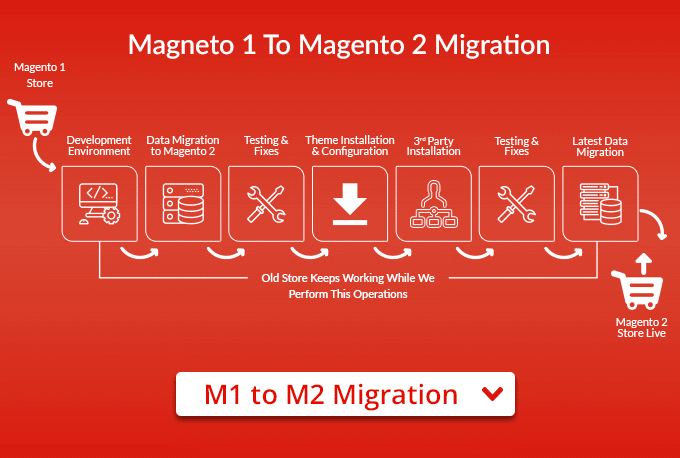Magento 2 Migration – How it can Boost Online Revenue and other Questions
The time for Magento migration has come. Why should I upgrade? Is it difficult to do? How can it benefit my business? How can it generate more revenue? We’ve put these questions to our lead developer to get the answers you need.
Even if your Magento 1 e-commerce store is running smoothly, without any issues, generates revenue and isn’t yet outdated, you should now start planning for Magento 2 to be prepared for the future. With its quicker operational tasks like stock updates, its more robust system, better server resource management and other new features there are several reasons why you should upgrade.
Why should I upgrade?
The Magento team have announced it’s time to upgrade your e-commerce website from Magento 1 to Magento 2. Whilst the development team adds new features to Magento 2 every 3 months, they plan to discontinue technical support for version 1 next year. Magento 2 offers a range of new features and opportunities that can improve your online store and boost your online revenue.
Is it difficult to do?
Your data is one of your most important online assets and the good news is Magento have kept this in mind. Migrating product, customer and sales data using the Data Migration tool is relatively easy but make sure to back up your database and files before you attempt to migrate to version 2.
The bad news is you will not be able to migrate the customised features and design that makes your online store unique. You will have to re-build them on the Magento 2 store and if your original Magento 1 was built by a developer, you will need to find a developer who is experienced in Magento 2 and migration. At UNBXD, our developers are experienced in Magento migration and are dedicated to making the process as smooth as possible.
Before you attempt the migration, we recommend making a copy of your website to use as a test site (preferably on a different server) to practice the migration on there without affecting the original site. This method is often referred to as a ‘staging environment’.
Magento 1 Backend Dashboard (Old/Dated)
Magento 2 Backend Dashboard (New/User-Friendly)
How can it benefit my business?
While several new features of Magento 2 enhance usability and the customer experience, a wide range of features were developed to improve the functionality for businesses.
The new, modern and simpler admin interface makes using Magento 2 efficient and easier for users at all experience levels.
While in Magento 1 all data was collected in the same database, Magento 2 offers the opportunity to slit data into product data, checkout and order, preventing databases from overloading.
Magento 2 has introduced the use of dashboards to display all important information. The dashboard can give you an overview of orders, sales, most viewed products and customer information etc.
Product uploads have become easier and included the option of uploading product videos alongside photos.
How can it generate more revenue?
Many of the improvements with Magento 2 are focused on enhancing user experience and functionality. In a previous blog post we wrote about how user experience increases conversion and boosts sales. Here are some of the most important new features:
Faster loading times
Magento 2 has decreased page loading times from 2-3 seconds to less than 1.5 seconds. This will increase conversion as if it takes too long to load pages on your website you face the risk of losing visitors who may convert and purchase.
Responsive design and SEO friendly
Magento 2 encourages mobile usage with its responsive format. Mobile e-commerce is becoming increasingly more popular and is expected to reach £33.2 billion by 2024. Responsive design enhances user experience and is favoured by Google’s search engine algorithms, increasing rankings and website traffic, all of which boosts conversion rates.
Streamlined checkout process
The new checkout process is much easier and faster for customers. Poor check-out processes can prevent customers from making a purchase and completing the order. By identifying registered customers by their email addresses and allowing guests to check out, with the option to register afterwards, checkout has become more efficient.
Ajax add-to-cart
In Magento 1, whenever a customer added a product their cart, the system would reload the page to obtain the data. This increased the loading time of the page for the customer and has a negative impact. If a customer must wait more than a few seconds before they can purchase, there is a greater chance they will abandon their cart.
Magento 2 has solved this issue using the AJAX system which prevents the page from refreshing and therefore enhances the user experience.
Due to the complexity of Magento 2 and to make the most of the new features, we advise seeking professional support, however Magento have developed a series of in-depth and easy-to-follow guides and information sheets on Magento migration to enable DIY migration.
Since Magento 2 is highly customisable, our professional developers can migrate and re-create the website you need to boost you online sales. Take a look at our successful Magento 1-2 migration in one of our case studies.
If you are interested in migrating your e-commerce site or are seeking any web development advice, contact a member of our team today.







